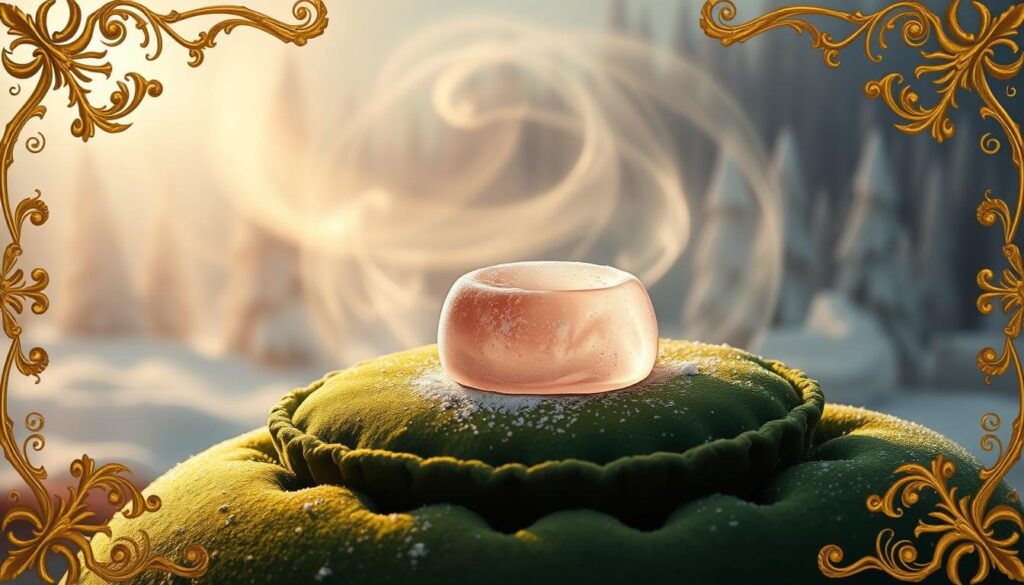Turkish Delight, a confection steeped in history and mystique, played a pivotal role in C.S. Lewis’s Chronicles of Narnia, particularly in The Lion, the Witch, and the Wardrobe. This enchanting candy, with its unique texture and flavor, was used by the White Witch to tempt Edmund, showcasing its allure and exotic luxury.
We will explore the historical significance of this candy and guide you through the process of creating authentic Turkish Delight at home, balancing traditional methods with accessible ingredients and the perfect sugar syrup consistency.
By understanding the cultural context and the role of sugar in this traditional confection, you’ll appreciate why C.S. Lewis chose Turkish Delight for his narrative, representing exotic luxury and temptation.
Key Takeaways
- Understanding the historical and cultural significance of Turkish Delight.
- Learning the traditional preparation methods of Turkish Delight.
- Creating authentic Narnia-inspired Turkish Delight at home.
- Achieving the perfect sugar syrup consistency.
- Appreciating the cultural context of Turkish Delight in The Chronicles of Narnia.
The Magical Allure of Turkish Delight in Narnia
In the enchanting world of Narnia, Turkish Delight represents a sweet yet treacherous temptation for Edmund Pevensie. The White Witch uses this luxurious confection to ensnare Edmund, setting in motion the central conflict of The Lion, The Witch and The Wardrobe.

Edmund’s Temptation in The Lion, The Witch and The Wardrobe
The pivotal scene where Edmund first encounters the White Witch and succumbs to the temptation of Turkish Delight is a crucial moment in the narrative. This encounter not only showcases the enchanting power of the candy but also symbolizes Edmund’s betrayal of his siblings.
Why Turkish Delight Was the Perfect Enchanted Candy
C.S. Lewis deliberately chose Turkish Delight for its exotic and luxurious appeal, which would have been particularly enticing in post-war Britain. The high sugar content and unique texture made it irresistible, embodying the themes of temptation and the consequences of giving in to selfish desires. Understanding the historical context of sugar rationing during World War II enhances the appreciation of Turkish Delight’s allure in the story.
Understanding Turkish Delight: A Historical Confection
As we explore the world of Turkish Delight, we uncover a rich history that spans centuries. This confection, known for its unique texture and flavor, has its roots deeply embedded in Ottoman cuisine.
Origins and Traditional Preparation
Turkish Delight, or lokum, originated in the late 18th century as a luxury confection in the Ottoman Empire. The traditional preparation involves heating sugar syrup and a cornstarch slurry mixture until it thickens into a gel, creating the distinctive texture of Turkish Delight. The process requires a delicate balance of sugar, starch, and flavorings.
- The authentic origins of Turkish Delight can be traced back to its Ottoman roots, where it became a staple of Turkish food culture.
- Traditional preparation methods involve careful cooking of the sugar syrup with starch to achieve the unique gel-like texture.
The Unique Texture and Flavor Profile
The Turkish Delight has a texture that is both chewy and soft, somewhere between gumdrops and Jell-O. Traditional flavor profiles often feature rose water, lemon, or orange blossom water, sometimes complemented with nuts like pistachios. The balance of sugar and starch allows the citric acid and extracts to shine through, preventing the delight from being overly sweet.
For those interested in trying their hand at making this historical confection, we have a detailed Narnia-inspired Turkish Delight recipe that brings this magical treat to life.
Essential Ingredients for Authentic Narnia Sweet Treat
Crafting the perfect Turkish Delight requires a deep understanding of its core components. To recreate this enchanting confection from The Chronicles of Narnia, we need to focus on the fundamental ingredients that give it its unique texture and flavor.
The Base Components: Sugar, Water, and Gelatin
The foundation of Turkish Delight lies in its base components: sugar, water, and a gelling agent. Typically, two cups of granulated sugar are combined with one cup of cold water to create the syrup base. The gelling agent can be either cornstarch or gelatin; we recommend using 1.5 envelopes of unflavored gelatin for a more accessible approach. This precise ratio of sugar to water is crucial for achieving the proper consistency.
Flavorings: Citrus, Rose Water, and Optional Add-ins
The distinctive flavor of Turkish Delight comes from its unique blend of flavorings. Citrus elements like orange and lemon juice add a bright, tangy note, while rose water or orange blossom water provides a traditional floral flavor. You can also add a touch of citric acid to balance the sweetness. Optional add-ins like chopped nuts (pistachios, walnuts, or almonds) can provide textural contrast, though the Narnia version appears to be nut-free. For coloring, a soft pink or red hue is traditional, achieved using red gel food coloring.
Step-by-Step Narnia Sweet Treat Recipe
To create an authentic Narnia Sweet Treat, follow our step-by-step guide to making Turkish Delight at home. This recipe will transport you to the magical land of Narnia, where the White Witch tempts Edmund with enchanted confections.
Preparing Your Workspace and Tools
Before starting, gather essential tools like a heavy-bottomed pan, candy thermometer, and appropriate setting pan to ensure recipe success. Prepare your workspace by clearing a clean, stable area for cooking and setting.
Creating the Sugar Syrup Base
Combine sugar and water in a saucepan and bring to the boiling point. Heat the mixture to the precise temperature (240-250°F or soft ball stage), which typically takes about 15-30 minutes of careful monitoring.
Adding Gelatin and Flavorings
Soak gelatin in one-half cupful of cold water for ten minutes. Add soaked gelatin and the juices of orange and lemon to the hot sugar syrup. Remove from heat and beat until creamy, incorporating flavorings and colorings into the mixture.
Setting and Cutting Your Turkish Delight
Pour the hot mixture into a prepared pan and allow sufficient time (typically 5-10 hours at room temperature) for the Turkish Delight to achieve its characteristic texture. Cut into cubes and coat thoroughly in powdered sugar for an authentic Narnia sweet treat appearance.
Expert Tips for Perfect Turkish Delight
Creating Turkish Delight that’s as enchanting as the one in Narnia requires attention to detail and a few expert tips. The secret to perfect Turkish Delight lies in the details, from achieving the ideal soft ball stage to exploring new flavors.
Achieving the Ideal Soft Ball Stage
To achieve the perfect texture, it’s crucial to get the sugar syrup to the ideal soft ball stage, between 240-250°F. We recommend using a candy thermometer for accuracy. If you don’t have one, you can test the syrup by dropping a small amount into cold water; it should form a soft ball that flattens when removed from the water.
Troubleshooting Common Issues
Common issues with Turkish Delight include failing to set properly or becoming too hard. These issues are typically due to incorrect cooking time or temperature. To avoid a grainy texture, it’s essential to avoid stirring the mixture during the boiling phase, allowing the sugar to crystallize correctly.
| Issue | Cause | Solution |
|---|---|---|
| Won’t set | Insufficient cooking time or temperature | Cook to the correct temperature (250°F) |
| Too hard | Overcooking the sugar syrup | Monitor the temperature closely |
| Grainy texture | Stirring during boiling | Avoid stirring during boiling phase |
Flavor Variations Beyond the Classic Recipe
One of the joys of making Turkish Delight is experimenting with different flavors. Try adding pistachio, pomegranate, or orange blossom to create unique variations. You can also dip your Turkish Delight in chocolate for an extra layer of flavor.
Serving and Storing Your Narnia-Inspired Treats
Serving and storing your homemade Turkish Delight is just as crucial as making it, to preserve its texture and flavor. To maintain the delightful coating, store the Turkish Delight pieces in an airtight container filled with a mixture of powdered sugar and cornstarch in a 2:1 ratio, burying them in the mixture to prevent sticking.
For an elegant presentation, consider serving your Turkish Delight on decorative dishes or boards, especially if you’re hosting a Chronicles of Narnia themed event. This will not only showcase your culinary skills but also evoke the magical world of the Witch and Wardrobe.
It’s worth noting that homemade Turkish Delight is best consumed within 72 hours, as it tends to lose its optimal taste and texture over time. Proper storage in a cool, dry place can help extend its shelf life. Enjoy your Turkish Delight with a cup of strong coffee or tea to enhance the experience, just as it’s traditionally enjoyed in its countries of origin.


